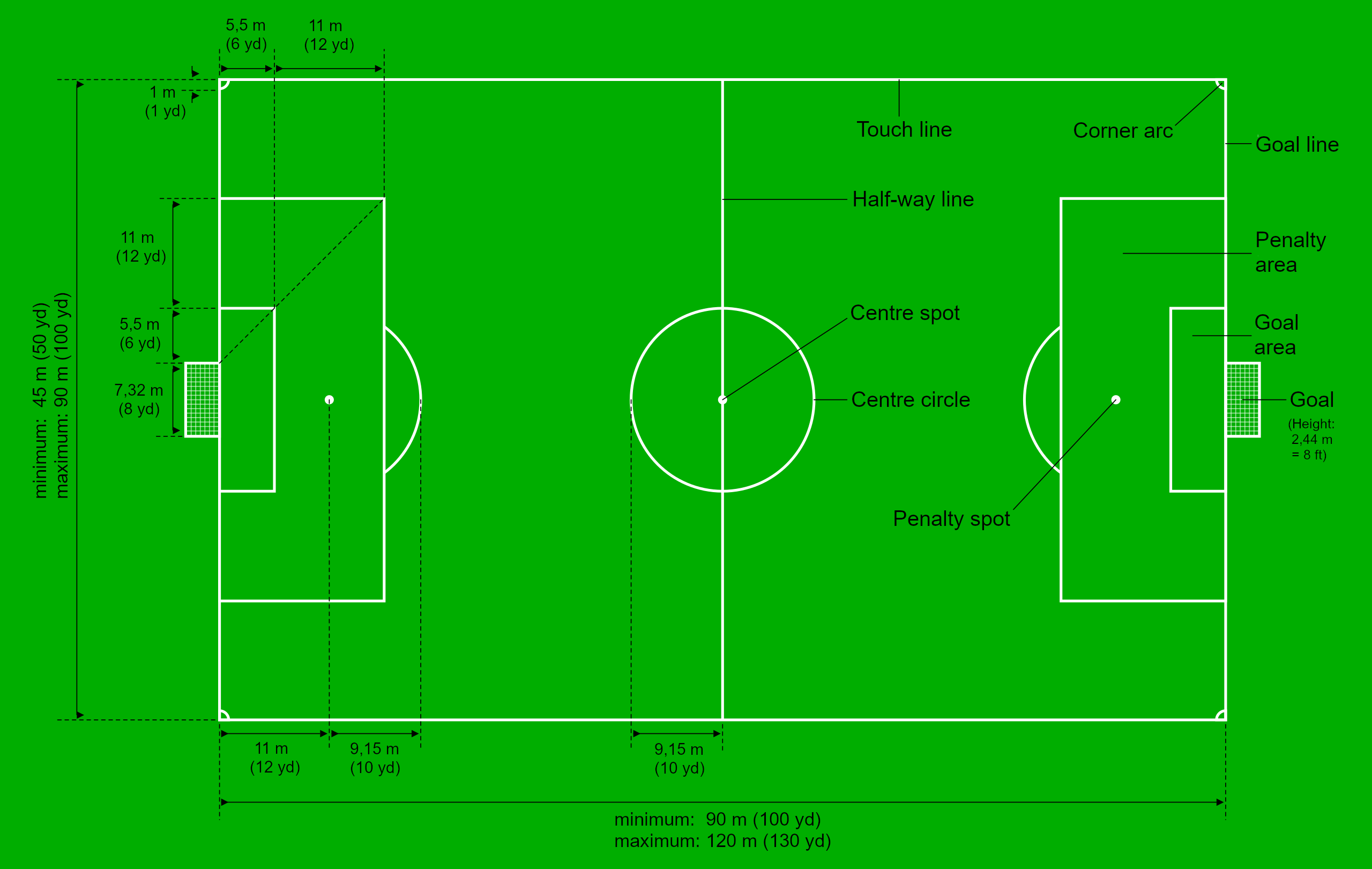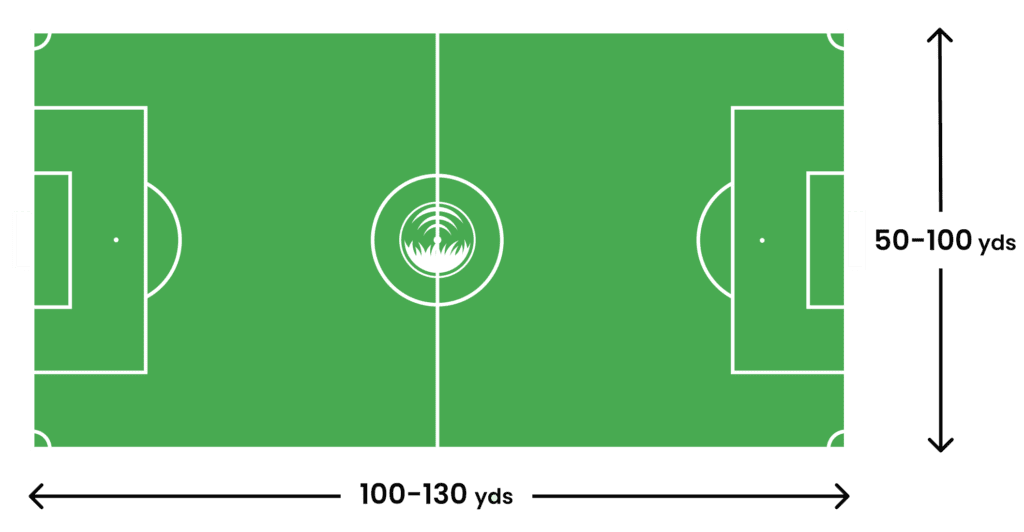Professional soccer field dimensions vary but typically range from 100-130 yards long and 50-100 yards wide. Soccer, known as “the beautiful game,” is played on a rectangular field called a pitch. The dimensions of a professional soccer field can vary depending on various factors, including the regulations set by different governing bodies and the specific needs of the stadium. We will explore the dimensions of a professional soccer field, focusing on the length and width of the pitch.
Understanding these dimensions is crucial for players, coaches, and fans alike, as it provides insights into the size and scale of the game at the highest level. Whether you’re a soccer enthusiast or simply curious about the sport, read on to discover the exact dimensions of a professional soccer field.
Table of Contents
Standard Dimensions
When it comes to organizing a professional soccer game, one of the most important factors to consider is the size of the field. The standard dimensions of a professional soccer field are defined by various organizations such as FIFA and MLS.
Length And Width
The length and width of a professional soccer field are standardized to ensure fair play and uniformity across different matches. The standard length of a soccer field is between 100 and 110 meters, while the width is between 64 and 75 meters. These dimensions provide enough space for players to maneuver, allowing for exciting gameplay and strategic movements.
Goal Size
The dimensions of the goal are another crucial aspect of a soccer field. The standard size of a goal measures 7.32 meters in width and 2.44 meters in height. These dimensions apply to both professional and amateur-level matches and are designed to challenge the players while maintaining fairness and balance in the game.
It’s important to note that the goal size may vary slightly depending on the specific league or tournament. However, these dimensions serve as a baseline for goal size in professional soccer worldwide.
In addition to the field and goal dimensions, some specific markings and lines contribute to the overall layout of a professional soccer field. These include the center circle, penalty area, and corner arcs. These markings ensure proper positioning and gameplay, enhancing the overall experience for both players and spectators.
So, the next time you watch a professional soccer match, take a moment to appreciate the precision and craftsmanship that goes into designing a field that meets the standard dimensions. It’s these small details that make the game so captivating and enjoyable for fans all around the world.

Variations In Dimensions
Soccer field dimensions vary, but a professional field typically measures 100-130 yards in length and 50-100 yards in width, conforming to FIFA regulations. In the US, MLS fields measure 110-120 yards in length and 70-80 yards in width, underpinning the varying dimensions of professional soccer fields worldwide.
International Standards
International standards, set by FIFA, dictate official soccer field dimensions for professional matches. The standard size ranges from 100-110 meters in length and 64-75 meters in width.
Local Variations
While FIFA provides guidelines, local variations exist across different leagues and countries. The MLS, for example, has its own set of specific field dimensions tailored to the league’s requirements.
Regulations and Requirements
Professional soccer field dimensions are regulated by FIFA, with the standard field measuring 100-110 meters in length and 64-75 meters in width. The regulations ensure consistency and fairness across professional soccer matches. Clubs and organizations must adhere to these requirements to maintain the integrity of the game.
Fifa Regulations
When it comes to professional soccer field dimensions, FIFA sets strict regulations to ensure standardization and fair play. According to FIFA regulations, the length of the field should be between 100-110 meters, and the width should range from 64-75 meters.
League-specific Requirements
Many leagues have their specific requirements for soccer field dimensions. These may vary slightly from FIFA regulations. For example, the MLS (Major League Soccer) in the United States has its own set of requirements, with the field length ranging from 100-120 yards and the width from 70-80 yards.

Impact on Gameplay
The dimensions of a professional soccer field have a significant impact on the gameplay. The size and layout of the pitch directly affect player strategies and performance, ultimately shaping the dynamics of the game.
Player Strategies
The field dimensions dictate how players strategically position themselves during the game. The width and length of the field directly influence the players’ movement and their ability to create and capitalize on scoring opportunities. Wider fields may lead to more expansive and wide-attacking gameplay, while narrower ones may result in a more compact and defensive style of play.
Effect On Performance
The dimension of the soccer field can impact the physical performance of the players. Larger fields may require greater stamina and endurance to cover more ground, while smaller fields may lead to more intense and physical gameplay in a confined space. Additionally, the surface area of the field can affect ball control and passing accuracy, influencing the overall performance of the players.
Historical Changes
Soccer field dimensions have undergone significant alterations throughout history, reflecting evolving trends in the sport.
Evolution Over Time
In the early days of soccer, fields were irregular in size and often unmarked, leading to inconsistencies in gameplay.
Reasons For Changes
The standardization of soccer field dimensions was necessary to ensure fair play and consistency across matches.
| Level | Field Size |
|---|---|
| Professional | 110-120 yards x 70-80 yards |
| High School | 100-120 yards x 50-100 yards |
- Improved player safety
- Enhanced viewing experience
Future Trends
As the world of professional soccer continues to evolve and adapt, so too do the dimensions of soccer fields. Future trends in the design and layout of soccer fields are being influenced by technological innovations and environmental considerations. These trends aim to enhance the playing experience, improve player performance, and minimize the impact on the natural environment.
Technological Innovations
New technologies are revolutionizing the way soccer fields are designed and maintained. Advancements in turf systems, goal-line technology, and player-tracking systems are reshaping the future of soccer fields.
- Turf Systems: Artificial turf has long been used as an alternative to natural grass due to its durability. However, advancements in turf technology now allow for more realistic playing surfaces that closely resemble natural grass. These advanced systems provide improved shock absorption and traction, reducing the risk of player injury.
- Goal Line Technology: Goal line technology is becoming a standard feature in professional soccer matches. This technology uses cameras and sensors to determine whether a ball has crossed the goal line, assisting referees in making accurate decisions.
- Player Tracking Systems: GPS-based player tracking systems are being integrated into soccer fields to collect real-time data on player movements, speed, and distances covered. This data can be used to analyze player performance, optimize training programs, and enhance tactical strategies.
Environmental Considerations
With growing concerns about the environmental impact of sports activities, there is a shift towards more sustainable and eco-friendly soccer field designs.
- Natural Grass Alternatives: The use of natural grass is being replaced with eco-friendly alternatives such as hybrid grass systems. These systems combine natural grass with artificial fibers to improve durability, reduce maintenance requirements, and minimize water consumption.
- Water Conservation: Water scarcity is a global issue, and soccer fields are no exception. Field designs are incorporating water conservation techniques such as rainwater harvesting and efficient irrigation systems to minimize water usage and maintain playable conditions.
- Solar-Powered Facilities: Soccer fields are increasingly utilizing solar power technology to meet energy demands. Solar panels are installed to generate clean and renewable energy, reducing reliance on traditional power sources and lowering carbon footprints.

Conclusion
Discovering the correct dimensions for a professional soccer field is crucial for the game’s integrity and players’ performance. Whether understanding FIFA’s guidelines or MLS field sizes, this guide provides valuable insights for enthusiasts and professionals alike. Unravel the measurements and markings for the ultimate soccer field experience.
 SMGB TODAY Sports, Movies, TV Shows
SMGB TODAY Sports, Movies, TV Shows

